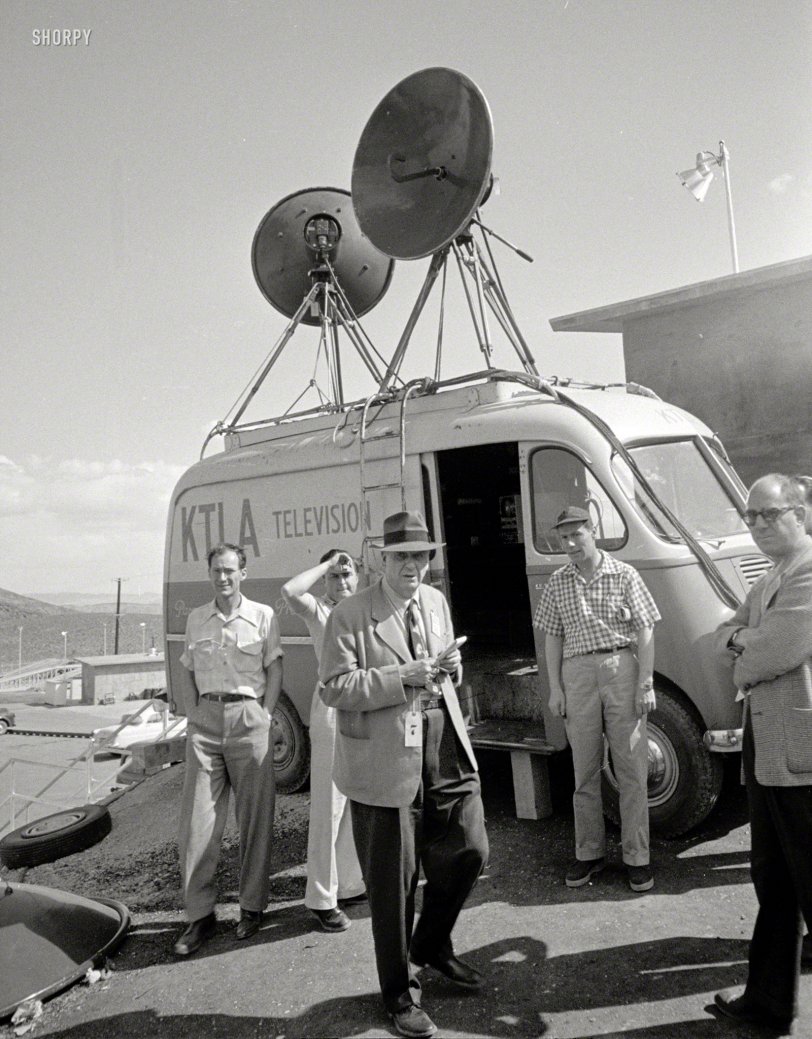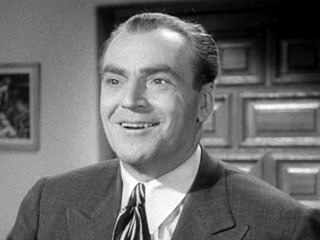


Framed or unframed, desk size to sofa size, printed by us in Arizona and Alabama since 2007. Explore now.
Shorpy is funded by you. Patreon contributors get an ad-free experience.
Learn more.

- Complicated then, forgotten now
- Bryan-Stevenson
- Skinny is as skinny does
- How do you rest in peace
- Riding the footboards
- Alas, hidden from view
- Baldwin Diesels
- Exclusive pump
- Bananas, Oysters and Smokey Joe
- Details, Details
- What's that building to the left of the tower?
- Coal Barges
- Bromo-Seltzer
- Inner harbor
- The Basin
- What a headache!
- Giant stepladder?
- Yeah, it was cold
- Love those coats
- Link & Pin Days Remnant
- Baldwin 62303
- Baldwin VO-1000
- Cold
- No expense spared
- Tough Guys
- What's your hurry, where's your hat?
- Sheriff's Signature
- Relocated in the Eighties
- Lost in Toyland
- And without gloves
Print Emporium
KTLA-Bomb: 1952

1952. "Journalists standing in front of a KTLA television truck at Camp Mercury Proving Grounds; present to record an atomic bomb detonation in the Nevada desert." Photo by Maurice Terrell for Look magazine. View full size.
Not Dick Lane
The man who did most of the talking on the broadcasts was a veteran journalist by the name of Gil Martyn (1905-1959). He was actually six years younger than Dick Lane, who didn't go to the blast. Stan Chambers told me that everyone who went to the blast eventually succumbed to cancer of some kind. Klaus Landsberg was the first. He died September 16, 1956, at the age of 40. Dick Lane, who was on the broadcasts, wasn't in Nevada. He was standing at the site of the KTLA transmitter at Mount Wilson. Gil Martyn had been serving as a news anchor, even before Stan Chambers arrived at the station. Commercials were live back then and interwoven into the broadcasts, much like the old Fibber McGee and Molly radio program. Director would give him a signal to go to a commercial. Stagehand would give Gil a bowl of soup with white soda crackers. He would extol the merits of the soup, take a couple of sips, and get back to reporting the news. What soup wasn't eaten remained on the counter behind him in the studio and that was part of his lunch.
Jonathan Rice
The man on the far right with his arms crossed in front of his chest is my late friend and mentor, Jonathan Rice. Jon worked briefly in the News Department of KTLA and occasionally mentioned that he was present at a nuclear weapons test.
In 1954 he was one of the founders of KQED-TV, San Francisco, one of the first public television stations to go on the air. He spent the entire remainder of his career with the station.
[Thank you! I'd been wondering why he looked familiar. -tterrace]
What was my father doing in Utah?
When I first looked at this photo, I thought it was a picture of my father. Then my husband looked at it and said "How did Shorpy's get a picture of your Dad?".
The reporter with the hat could be my father's twin. My father dressed in similar clothing most of his life. In fact he continued to dress like that until he passed in 2002. He never went anywhere, in public, without a jacket and his hat. Although when he reached his 80's, he relaxed a bit and stopped wearing a tie.
[For that matter, what was he doing in Nevada? -tterrace]
Mr. Television
Thanks to pedrocooper for the fascinating link, from which I can identify the fellow in the checkered shirt and ball cap as Paramount Pictures' "Mr. Television", Klaus Landsberg. Landberg's pioneering work in television was not limited to engineering and inventions; he was also a producer and director. Having built station KTLA for Paramount, Landsberg created the microwave relay network for this first ever live telecast of an atomic bomb test.
International Harvester
The truck is an International Harvester Metro Van. The Metro Vans were made by the Metropolitan Body Company of Bridgeport, Connecticut. Metropolitan supplied these bodies, in a variety of styles, from 1938 to 1948 to IH. In 1948 International purchased Metropolitan and Metropolitan then continued to run as a wholly owned subsidiary of IH. The beginning of the full model number (KB) can be seen behind the man in the checkered shirt. The last Metro Van was produced in 1972. After 1972 chassis were available to independent body builders to make their own vans.
The Metro Van pictured here was made from 1947, when the protruding headlights were introduced, to 1949, the last year for the original style grille. Note the large block of wood below the van's step - possibly to provide additional support while loading and unloading heavy camera and satellite equipment.
Fission Expedition
The story of setting up the microwave link from Los Angeles to Camp Mercury is recounted in a 1986 Museum of Broadcasting publication:
Metro Van
Not as iconic as the Divco milk truck, but even more versatile, in roles ranging from home-delivering Bond bread to shuttling flight crews between base ops and the flight line on many an air force base.
Microwave
Dishes aimed horizontally instead of upwards is the distinct change.
The telephone microwave towers around Ohio came down in the 1990s, though the towers themselves remain standing. The lawn maintenance went way down.
That was the old version of fiber optics for high bandwidth channels. Take as much spectrum as you need but keep it in a narrow beam to avoid interfering with anything.
Good Numbers
This would have been the CHARLIE shot of Operation Tumbler-Sanpper on 22 April 1952. It was a 31 kiloton airdrop from a B-50 bomber and was the first televised atomic test.
TV covered all kinds of things in its infancy in order to gain an audience. And in the middle of the Korean War, a demonstration of our then most powerful weapon had more telling overtones than mere entertainment. The AEC was also out to demonstrate the safety of testing in Nevada following the first tests there the year before. That created the odd juxtaposition of watching the safety of nuclear weapons being "demonstrated" by the AEC on a TV that your grandparents were warning you against getting too close to because of the radiation from its cathode ray tube. "So what's more dangerous Gramps, the TV or fallout?"
In March 1953, the AEC tried to talk newly-elected President Dwight Eisenhower into attending the ANNIE shot. After some back and forth over who was going to pay for the broadcast, out of concern that it might appear as if the president, and not the atomic test, was being supported by the show's sponsor, the White House let discretion be the better part of valor and declined the AEC's invitation.
Whoa, Nellie!
I'm going to guess that guy in front is the legendary KTLA announcer Dick Lane, well known to Los Angeles residents of the 50's for his coverage of everything from oil well fires to roller derby and wrestling matches, and just about anything deemed sensational enough to fill up air time on a budget. You could recognize his voice in a second, and he knew how to fill up non-stop stretches live television event coverage with snappy banter. An atomic bomb test would be right on track for good old Dick.
[Definitely not Dick Lane, who was also a familiar face in B-picture supporting roles from the late-1930s through the 1940s. He was 53 in 1952. Below in 1945 in the Laurel and Hardy feature "The Bullfighters". -tterrace]

Coincidence
I was just at the National Nuclear Testing Museum in Las Vegas last Wednesday. There are a number of exhibits about these tests. Quite interesting and worth a couple of hours next time you need to escape the non-stop craziness that is Vegas.
Portable microwave TV relay
This must be the very early days of portable microwave relay equipment for TV reporting. Does anyone have any information on the history? (And BTW, is that a discarded microwave dish in the lower left?)
Televised A-test
I remember watching an A-bomb test (was it from Yucca Flats, Nevada?) on our 10-inch round Zenith TV.
























On Shorpy:
Today’s Top 5